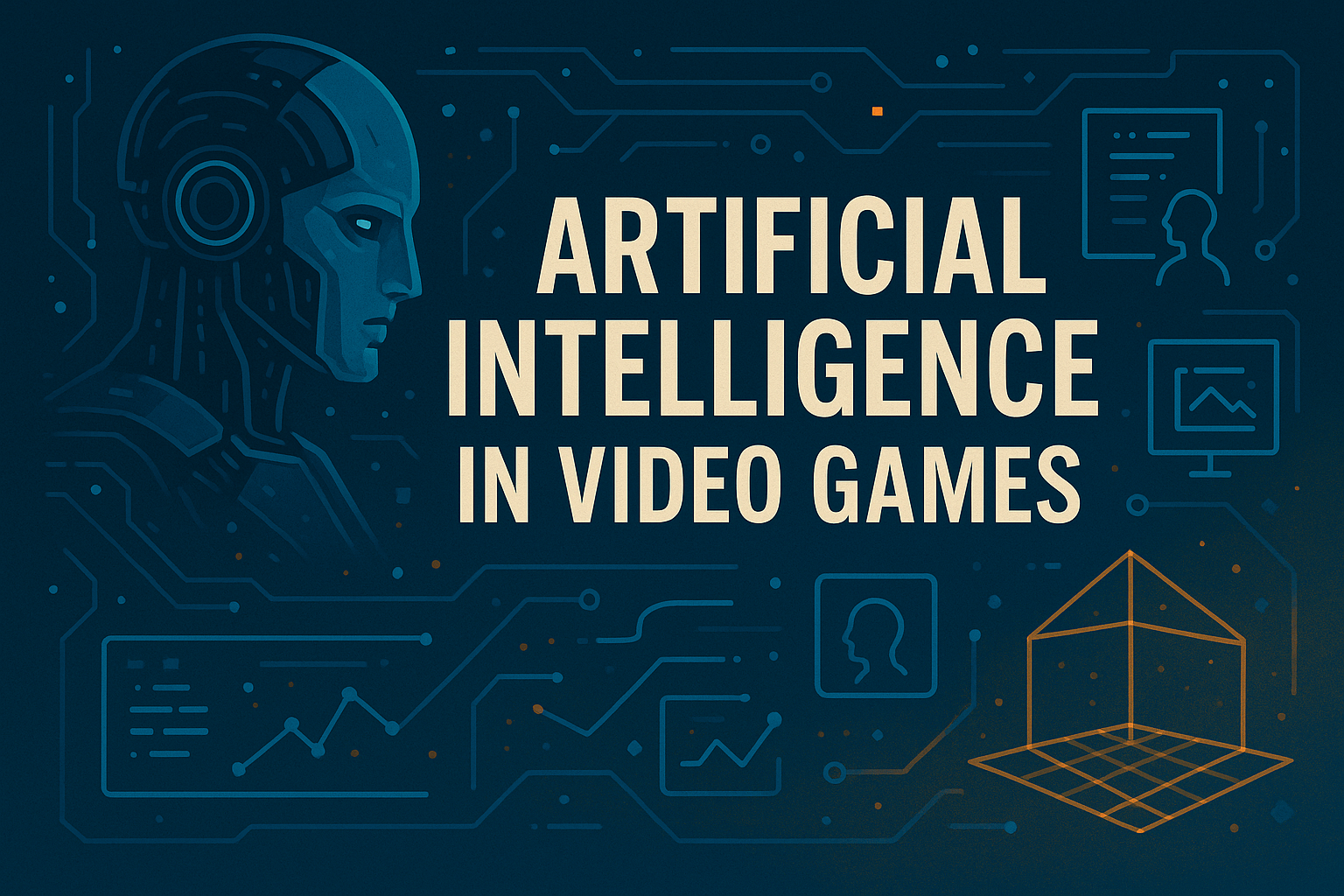How Artificial Intelligence in Video Games Is Changing Everything
AI in video games is no longer science fiction. It’s reshaping how we play, design, and even understand games. Whether you’re a casual gamer or a pro developer, you’ve already felt its impact. Enemies no longer follow static paths. Worlds evolve with your actions. Narratives shift based on your choices. All thanks to artificial intelligence in video games.
This technology now fuels everything from smarter enemies to entire game worlds that build themselves. Procedural generation, adaptive difficulty, and predictive behavior are no longer optional—they’re expected. Developers harness the power of neural networks and deep learning to create rich, unpredictable experiences. Players crave immersion. AI delivers it.
But this evolution also raises questions. How far can we go? What happens when AI begins writing stories, balancing difficulty, and designing gameplay with minimal human input? Can AI in video games replace the human spark that made gaming magical in the first place?
More importantly, how do players feel about AI anticipating their every move? Personalization sounds fun—until it starts shaping your play style in ways you didn’t choose. That’s the power, and danger, of artificial intelligence in video games.
In the next sections, we’ll dive deep. You’ll discover how AI is becoming the world’s smartest game designer, the brain behind lifelike NPCs, and even a tool for monetization. The gaming world will never be the same—and neither will you after reading this.

From Code to Creativity: AI as a Game Designer
In 2025, AI in video games is no longer a background tool. It’s a creative force. Game developers use AI to build entire worlds, generate quests, and craft dynamic environments that respond to the player’s decisions. The days of static levels and predictable missions are over.
AI-driven tools like Promethean AI help artists generate 3D environments in seconds. Instead of designing every corner manually, creators now guide the AI, which fills in the blanks with astonishing detail. This speeds up production and unlocks levels of creativity previously impossible.
But AI isn’t just speeding things up. It’s changing how games are made. Procedural content generation allows infinite variations of levels, puzzles, and environments. Games like Minecraft, No Man’s Sky, and Hades use this technology to create rich, non-repetitive gameplay. Each player experiences something unique.
What’s more, narrative AI can now write branching dialogues and stories that adapt to player choices. Platforms like Charisma.ai let developers create characters who understand context, remember past events, and evolve with the player. This creates emotionally engaging experiences once reserved for film and literature.
With artificial intelligence in video games, the developer’s role is transforming. They are no longer solely creators—they’re also curators of AI-generated possibilities. This synergy between human intuition and machine logic sparks innovation.
Still, not everything is perfect. AI can generate content that feels artificial or lacks soul. That’s why human oversight remains essential. Yet, as these systems improve, they’ll get better at mimicking human creativity—and sometimes, surpassing it.
Are we witnessing the birth of a new kind of artist? In the world of gaming, it’s already happening.
Unity explains how AI shapes modern game development
Smarter NPCs: Characters That Learn and Adapt
Non-playable characters (NPCs) used to follow simple paths. They walked, talked, attacked, or died. But now, artificial intelligence in video games gives them brains. These characters observe, react, and even learn from the player’s actions. The result? A gaming experience that feels alive.
Take Middle-earth: Shadow of Mordor. Its Nemesis System uses AI to create enemies who remember you. If you defeat them, they might return stronger. If they beat you, they mock you later. This isn’t scripted drama—it’s AI-driven storytelling. The system creates unique rivalries that no two players experience the same way.
Games like Alien: Isolation pushed this further. The alien creature doesn’t follow a fixed route. Instead, it uses AI-powered decision trees to hunt the player intelligently. It adapts to your hiding spots, forcing you to evolve your strategy. Every encounter feels real.
Now imagine machine learning applied to these systems. Developers are experimenting with neural networks that let NPCs learn in real time. They study your playstyle and adjust accordingly. If you rely on stealth, enemies may increase patrols. If you favor brute force, they defend more aggressively.
These smart NPCs enhance immersion. Players feel watched, challenged, and respected. And the AI never forgets. It stores data from your previous encounters and builds a personality around it.
However, smarter NPCs also raise questions. Can AI characters manipulate us emotionally? What if they’re too good at mimicking human behavior? Will we still know who’s real?
Artificial intelligence in video games has transformed NPCs from tools into characters with purpose and personality. Soon, they won’t just react—they’ll lead, influence, and maybe even teach us something new about ourselves.
MIT explores the future of AI NPC realism
Dynamic Gameplay and Personalized Difficulty
Modern gamers expect more than challenge. They want games to understand them. Thanks to AI in video games, that’s now possible. AI adjusts difficulty, pacing, and even game mechanics to match each player’s behavior in real time.
Think about Left 4 Dead. The game features an AI Director that changes enemy spawns, weapon placements, and tension levels based on how well the player performs. If you’re doing too well, it increases the pressure. If you’re struggling, it eases off. This creates a balanced, thrilling experience every time.
Now, developers are taking that further. With machine learning models, games can track user inputs, decision-making speed, and even hesitation. They analyze patterns and predict frustration or boredom. Then, they dynamically shift gameplay to keep the experience fun and engaging.
This isn’t just about difficulty. It’s about personalized game design. Imagine a game that adjusts the storyline based on your risk-taking. Or one that changes the environment if you tend to explore every corner. These AI features transform linear games into living systems.
The benefits are huge. Players feel seen. They stay engaged longer. The game adapts to their rhythm, not the other way around. This improves retention and boosts satisfaction.
Yet, there’s a fine line. Some players might feel manipulated if they notice the AI adjusting too obviously. Others may miss the challenge of fixed difficulty. That’s why transparency and player control remain vital.
Still, the future is clear: artificial intelligence in video games will shape every interaction. Not just what happens, but how and when it happens—creating gameplay that feels like it was designed just for you.
Read how OpenAI uses reinforcement learning in interactive systems
Predicting Players: Behavior, Choices, and Monetization
Gaming isn’t just about playing anymore—it’s about predicting. Today, artificial intelligence in video games helps developers understand how players think, move, and spend. AI systems don’t just react. They anticipate your next step.
Modern games track more data than ever. Every click, pause, and path you take feeds into an AI model. These models analyze your habits to improve design—but also to drive monetization. They predict when you might lose interest, then offer rewards or upgrades to keep you hooked.
Games like Fortnite and Genshin Impact use AI to optimize engagement. When do you stop playing? What makes you spend? AI predicts these moments and triggers personalized offers. This leads to higher revenue and longer playtime.
Even more impressively, AI can shape your decision-making. By studying your behavior, it suggests missions, unlocks features, or changes challenges to align with your preferences. It’s subtle, but powerful. You feel like you’re choosing—but the AI gently nudges you along.
This personalization can feel magical. But it also sparks ethical concerns. If AI knows exactly when you’re vulnerable or impulsive, it can push you toward unnecessary purchases. That’s not design—it’s manipulation.
Artificial intelligence in video games must strike a balance. Used right, it improves fun and flow. Abused, it turns play into a profit trap. Developers have a responsibility to create transparent systems that inform players, not exploit them.
As AI grows smarter, the line between game design and behavioral psychology blurs. Will future games simply entertain—or will they control?
It’s time to ask: who’s really playing who?
The Future of AI in Games: Where Do We Draw the Line?
The future of AI in video games looks incredible—and a little unsettling. As AI evolves, its role in gaming deepens. It writes stories, creates characters, tests code, and predicts outcomes. But how far should it go?
Some studios already experiment with fully AI-generated games. From narrative to visuals, machines do everything. Tools like Scenario.gg and Inworld AI allow AI to invent worlds, design behaviors, and even write realistic dialogue. Human developers become overseers rather than creators.
This changes the core of game development. Will human creativity still matter if AI can match or exceed it? That’s not a hypothetical. Some AI-generated assets now outperform human work in speed and, in some cases, originality. But without human insight, games may lack emotional depth.
There’s also the question of jobs. AI doesn’t sleep. It doesn’t ask for a salary. As studios seek efficiency, will they replace writers, testers, or artists with algorithms? And what does that mean for the diversity of voices in gaming?
Even players might be affected. If AI tailors every aspect of gameplay, we may never face a real challenge. Games could become too easy, too perfect—less about discovery, more about prediction.
And yet, AI holds massive potential. It can open doors for small creators, reduce costs, and unlock game ideas we’ve never imagined. But we must guide it with ethics and purpose.
Artificial intelligence in video games will shape the future of play. But it’s up to us to decide what kind of future we want. One where AI enhances creativity—or one where it replaces it.
Let’s not wait until it’s too late to draw that line.
Is AI the Real Final Boss? Join the Battle!
You’ve just explored the incredible rise of AI in video games—from code to creation, from data to emotion. You’ve seen how AI builds worlds, reads players, crafts characters, and even nudges us to spend. It’s thrilling. It’s terrifying. And it’s real.
Now, ask yourself: where do you stand?
Are you amazed by the limitless creativity AI brings to gaming? Or are you worried it might replace the human spark that makes play meaningful? Maybe you’re both. That’s the magic—and the danger—of this moment.
Artificial intelligence in video games is no longer the future. It’s shaping how we think, play, and connect today. And your opinion matters.
🎮 Tell us what you think.
🧠 Do you trust AI as a storyteller?
💬 Should games predict your every move—or surprise you instead?
Join the conversation now on Facebook and Instagram. We want your ideas, your doubts, your fire. This isn’t just our story—it’s yours too.
Become part of the Tooup movement. Be a voice in the new era of play.
Let’s shape the future of gaming—together.



